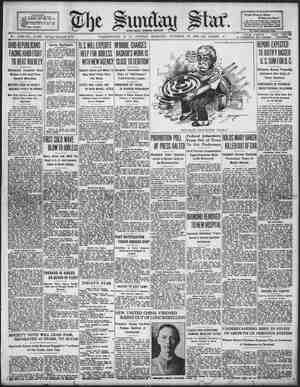Evening Star Newspaper, October 19, 1930, Page 87
You have reached the hourly page view limit. Unlock higher limit to our entire archive!
Subscribers enjoy higher page view limit, downloads, and exclusive features.
Fiction Art PART 7. @he Sundiy Shet Magasine WASHINGTON, D. C, OCTOBER 19, 1930. Features | . Books 24 PAGES. NewRusk forPirate’s Gold Along Louisiana’s Gulf Coast a New Hunt Is On for the Treasure of Lafitte, Last of the Great Pirates—Another Chapter in the Long Story of Adventure and Tragedy Centering Around These Legendary Riches. By Lyle Saxon. ~ Author of “Lafitte the Pirate,” “Fabulous New Orleans” and “Old Louisiana.™ Imprisoned. Drawn by E. H Suydam. DAY, as you read this, men are 'digging for buried treasure on the Louisiana coast. And the y restless ghost of Jean Lafitte is * abroad again. Less than a week ago an expedition set sail for its secret destination some- where among the low-lying islands in the Mexican Gulf. The men aboard the lugger were sure—just as countless " others have been sure—that long lost treasure would soon be theirs. Silver " bars and fabulous gems, hidden in the sand. Golden doubloons and pieces of eight. ¥or more than a century men have searched for Lafitte’s treasure. The quest has moved onward for a thousand miles along the Mexican Gulf, and has included every bay, inlet and bayou from Key West to the mouth of the Rio ~ Grande. Through all the years strange tales of gold and jewels have been re- peated, and the treasure has grown with each year that has passed. _ Florida, Alabama, Mississippi, Louis- fana and Texas—all have their legends. Some have to do with golden bars buried on a sandy beach; others tell of treas- ure-laden vessels which went to the bottom in storms; still others deal with scuttled ships which rest now on the ocean’s bed—or in bayou or bay—where, locked away in iron chests, the treasure awaits discovery. The fact that numerous small sums have been found at long intervals, and at widely scattered points, has kept the legend alive; and there are always men in each generation who search. It would be easy to fill a volume with fantastic tales of these men, but a few examples must suffice. " In 1851 a sum of money was found on Buried Treasure. ' Caillou Island. The newspaper accounts are meager, but “it is rumored that $20,- 000 in Spanish doubloons was found.” A later account, in the same newspaper, puts the sum at $2,000. But this find on Caillou started a search that continued for many years. The newspapers of the period tell of many expeditions setting sail; but 1 have been unable to find one story of a triumphant return. HE Gulf coast, it will be remembered, was Spanish territory for nearly a century; and the Spanish are renowned for hiding things away. There is an old saying in the Gulf country that a secre- tive person is “like a Spanish cat,” for Spanish cats, you understand, bury trinkets as dogs bury bones—an asser- tion which you may take with a grain of salt, if you wish. But most of the discovered treasures were hidden in Spanish times. Mississippi and Louisiana planters en- A dnwm.br Howard Pyle. Copyright by Harper & Bros. tombed their valuables during the Civil War, when these States were invaded by the Federal troops. Some of the men who did so died in the Confederate Army and their possessions remained in the earth. Others buried jewels or silver, left their homes and never re- turned. There are even stories of people who “forgot” where things were placed, and their grandchildren are still hunting for them. Not very long ago, in making a hole for a gate post, a plantation family of Louisiana discovered more than 100 bottles of fine old whisky. But every discovery, no matter how trivial, gives new faith to those who find " it difficult to believe history and easy to believe legend. And the buried treasures are always said to have been secreted by Jean Lafitte, the last of the great pirates. New Orleans a century ago produced many fantastic characters, but Jean Lafitte—the pirate who turned patriot, then turned back to piracy again—was . The Lafitte Brothers Old Blacksmith Shop.. Pt g by Drawn by Ei H. Suydam, one of the most extraordinary of them all. With his brother Pierre this young Frenchman came to Louisiana early in the nineteenth century and opened a blacksmith shop. While Negro slaves hammered out iron griliwork and lace- like balcony railings at the forge, the brothers took their place in that gay panorama of Creole life, and were soon well known figures at the theater, the opera, the coffee houses, the gambling saloons and the Quadroon ballrooms. Secretly, Jean Lafitte was leader of the Baratarians, smugglers, who lived among the islands in the Mexican Gulf just off the Louisiana coast. Such genius had Lafitte for organization and manage- ment that his followers soon numbered more than a thousand men “of every shade of complexion and villainy.” Now- adays we could call him a gang leader or a racketeer; his racket was smuggling, then privateering against Spanish vessels, and, eventually, piracy. He be- came known to posterity as the last of the great American pirates, but he was really America’s first great racketeer. Claiborne, Louisiana’s first American Governor, cffered a reward for Lafitte’s capture; but the buccaneer swaggered through the streets of New Orleans, a dangerous man whom no one dared molest. . WHEN the British vessels apprcached . Louisiana durigg the War of 1812 the commodore of the invading fleet at- tempted to e¢nlist the aid of Lafitte and his Baratarians against the American -forces. Had the pirate accepted, it is probable that the British would have captured New Orleans. Instead, Lafitte pretended to agree; then he betrayed
